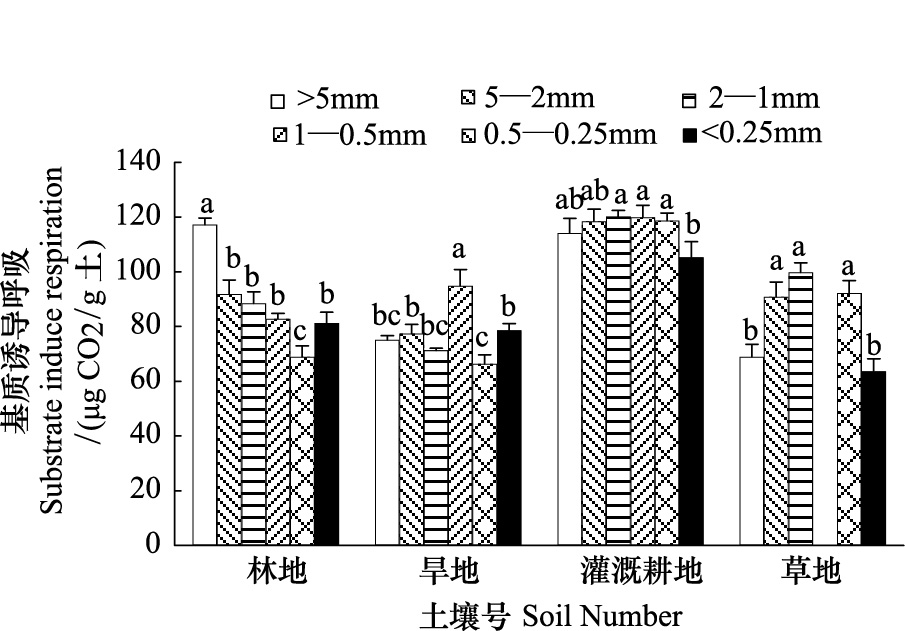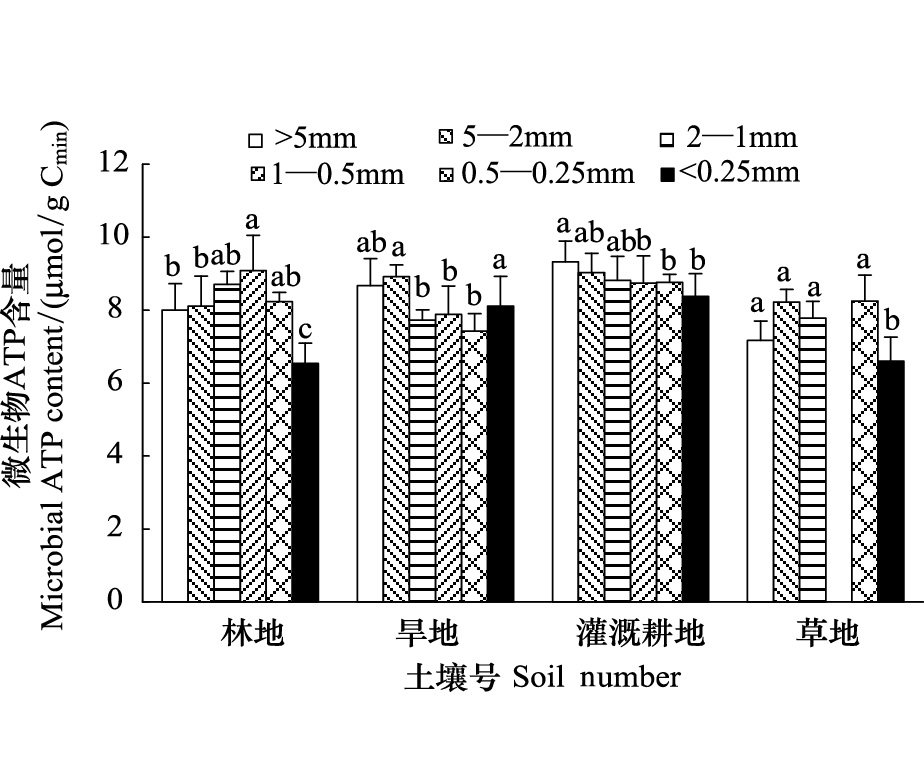文章信息
- 文倩, 李培培, 林启美, 李青松
- WEN Qian, LI Peipei, LIN Qimei, LI Qingsong
- 半干旱地区不同土地利用方式下土壤团聚体的微生物量属性
- Characteristics of microbial biomass attributes in soil dry aggregates from lands of different uses in the semi-arid area
- 生态学报, 2014, 34(24): 7403-7410
- Acta Ecologica Sinica, 2014, 34(24): 7403-7410
- http://dx.doi.org/10.5846/stxb201303180446
-
文章历史
- 收稿日期:2013-03-18
- 网络出版日期:2014-03-19
2. 中国农业大学资源环境学院, 北京 100193
2. College of Resources of Environmental Sciences, China Agricultural University, Beijing 100193, China
土壤微生物量属性包括微生物量、三磷酸腺苷(ATP)、代谢活性、呼吸熵等,由于其在土壤生物学性质中的核心地位,能够迅速响应土壤污染、土地利用、土壤管理等多种变化[1, 2, 3, 4],且易于测定,常用于指示土壤质量的指标[1],比土壤物理或化学属性指标,更为敏感快速地指示土壤质量的变化[5, 6]。
土壤团聚体是土壤的重要结构单元,是土壤中物质和能量转化及代谢的场所,其数量和质量直接决定土壤质量和肥力[7]。土壤团聚体由无机和有机物质胶结而成,其中微生物起着非常重要的作用,许多细菌细胞和真菌菌丝直接参与土壤颗粒的团聚作用[8]。不同粒径的团聚体,其物理和化学环境存在差异,故其微生物数量与种群差异也很大,如退化草地土壤<0.25 mm团聚体微生物量碳含量为153 mg/kg、微生物量氮含量为11.4 mg/kg,分别是>1 mm粒径含量的2/3和1/2[9, 10]。但微生物的新陈代谢活性是否也存在差异,目前也并不很清楚,而在生态环境脆弱的农牧交错带不同土壤团聚体这方面的资料尤为稀少,因此将CO2、ATP 、SIR和微生物量碳结合起来研究,可能会更加敏感而有效地指示环境的差异,全面综合地反映土壤微生物量属性特征及其差异。鉴于此,我们从内蒙古地区,采集4种土地利用方式的表层土壤,用干筛法获得不同大小的团聚体,分析各级团聚体微生物量属性指标,以期:(1)了解不同干团聚体微生物量属性的特征与差异;(2)土地利用方式的改变,是否引起土壤团聚体微生物量属性变化,其变化特征是什么?
1 材料与方法 1.1 土壤4 个土壤均于2004年5月上旬采于内蒙古武川县中国农业大学旱农试验站,分别为1个草地土壤,主要植被类型为羊茅和蒿类,1个20年生杨树林地土壤(小老头林),1个旱地土壤(油菜-土豆)和1个灌溉耕地土壤(玉米-小麦)。用铁锹多点采取0—20 cm表层土壤,尽量避免挤压,以保持原状土壤结构。在室内沿自然结构轻轻掰成直径约1 cm的小土块,除去植物残体、石块及蚯蚓等。取少量土壤用于测定土壤基本性质(表 1),余下的土壤用干筛法[11]分离出>5 mm、5—2 mm、2—1 mm、1—0.5 mm、0.5—0.25 mm、<0.25 mm 6级团聚体(振荡式机械筛分仪,最大功率,10 min)。调节土壤至50%田间持水量,在25 ℃预培养7—10 d后,立即测定土壤微生物属性或将土壤置于低温(4 ℃)下保存,所有测定均为3个重复。试验土壤的基本性质见表 1。
| 土地利用类型Land use types | pH | 粘粒/(g/kg)Clay | 有机碳/(g/kg)Organic matter | 全氮/(g/kg)Total nitrogen | 微生物量碳/(mg/kg)Microbial biomass carbon | K2SO4浸提碳 /(mg/kg) K2SO4-C | K2SO4浸提氮 /(mg/kg) K2SO4-N |
| 1 ) 不同土壤有机碳、全氮、微生物量碳、K2SO4浸提碳、K2SO4浸提氮间的比较,不同字母间差异达0.05显著水平 | |||||||
| 林地Woodland | 8.38 | 20.4±1.3 c1) | 17.71±0.01 c | 1.48±0.06 a | 207.53±0.71 c | 55.44±0.43 a | 3.39±0.21 a |
| 旱地None-irrigated cropland | 8.42 | 27.3±1.8 b | 18.88±0.43 b | 1.33±0.01 b | 216.11±0.26 b | 35.11±0.23 d | 3.44±0.09 a |
| 灌溉耕地Irrigated cropland | 8.56 | 32.2±2.1 a | 29.93±1.50 a | 1.85±0.02 d | 336.03±1.28 a | 50.90±0.46 b | 2.94±0.23 ab |
| 草地Grassland | 8.76 | 12.2±0.5 d | 12.48±0.44 d | 1.35±0.05 b | 217.69±3.61 b | 38.06±0.86 cd | 2.15±0.13 b |
称取相当于20 g烘干土重的预培养土壤于100 mL玻璃瓶,放入盛有20 mL 1mol/L NaOH以及10 mL蒸馏水的1 L棕色玻璃瓶,密闭后于25 ℃培养10 d,设置不添加土壤空白,各重复3次。NaOH溶液用自动滴定仪(TTT80,法国)以0.5 mol/L HCl滴定(pH值 8.3—3.7),然后计算微生物基础呼吸量。基础呼吸CO2的量与微生物量碳的比值相当于微生物量新陈代谢熵(qCO2)。
1.2.2 土壤ATP土壤ATP的提取用三氯乙酸(TCA)法[12]。ATP用荧光素-荧光酶法测定[13]。向荧光素中加入10—12 mL高纯水,再将溶解的荧光素加入荧光酶瓶中,加水至50 mL,存储于-15 ℃,使用时避光放在碎冰里。吸取50 μL浸提液A和B至10 mL砷酸盐缓冲液中,加入50 μL的荧光素-荧光酶溶液,用Packard(2500 TR)液体闪烁记数仪测定。
1.2.3 土壤微生物基质诱导呼吸(SIR)SIR率用改进的West和Sparling方法[14]。称取15g烘干重土壤(<2mm)3份,放入250 mL三角瓶中,以每克土壤6 mg葡萄糖的比例加入葡萄糖溶液,调整土壤含水量到田间持水量的120%,密闭后将三角瓶在120 mpv、25 ℃下旋转培养2h,用注射器吸取10 mL气体于20 mL真空玻璃瓶中,吸取5 mL CO2用气象色谱仪测定,3个重复。
1.2.4 土壤微生物量碳土壤微生物量碳用氯仿-0.5 mol/L K2SO4熏蒸浸提法测定,熏蒸提取采用Vance等人的步骤[15],浸提液中可溶性碳用重铬酸钾氧化外热源法测定,转换系数为2.6。
1.3 数据统计与分析所有分析皆为3次重复,用烘干土壤质量表示,采用Excel 2003软件对数据进行统计分析,最小显著差异法(LSD)进行多重比较。
2 结果分析 2.1 不同利用方式下土壤微生物量属性土壤ATP含量与微生物量ATP浓度在灌溉耕地和旱地土壤较高、草地和林地较低(表 2),灌溉耕地土壤微生物BR是草地、旱地和林地的3倍,而诱导呼吸量则高出1—2倍。除灌溉耕地土壤外,草地土壤的SIR、基础呼吸和微生物新陈代谢熵也比较高,林地和旱地土壤则较低。
| 土壤微生物量属性Soil biochemical properties | 土地利用类型Land use types | |||
| 林地 Woodland | 旱地none-irrigated cropland | 灌溉耕地Irrigated cropland | 草地Grassland | |
| 1 : Microbial biomass carbon- MBC,Adenosine triphosphate-ATP,Substrate induce respiration-SIR,Basic respiration-BR,Metabolic quotion- qCO2; 2: 不同土壤基础呼吸、基质诱导呼吸、ATP含量和微生物量代谢商间比较,不同字母间差异达0.05显著水平 | ||||
| 微生物量碳MBC1/(mg/kg) | 207.53±0.71 c2 | 216.11±0.26 b | 336.03±1.28 a | 217.69±3.61 b |
| 土壤ATP含量 ATP content/(μmol/g soil) | 0.00162±0.00013 b | 0.00182±0.00010 b | 0.00311±0.00011 a | 0.00178±0.00002 b |
| 微生物量碳ATP含量ATP/MBC/(μmol ATP/g Cmic) | 7.76±1.03 b | 8.44±0.63 b | 9.26±0.68 a | 8.17±0.64 a |
| 基质诱导呼吸SIR/(μg CO2-C g-1 d-1) | 90.61±1.78 b | 88.66±2.80 b | 132.17±4.75 a | 95.59±2.29 b |
| 基础呼吸 BR/(μg CO2-C g-1soil d-1) | 3.26±0.25 b | 3.33±0.26 b | 10.31±0.49 | 3.95±0.42 |
| 新陈代谢熵qCO2/(μL CO2-C g-1 Cmic d-1) | 0.352±0.03 c | 0.345±0.03 c | 0.687±0.03 a | 0.406±0.04 b |
土壤团聚体BR日均在2.2—9.9 μg/g土之间(图 1),其中草地土壤<0.25 mm粒级团聚体呼吸量最低,而灌溉耕地土壤5—2 mm粒级团聚体呼吸量最高,二者相差近5倍。灌溉耕地土壤BR含量与林地、草地和旱地土壤土壤团聚体BR含量有显著差异(P<0.01)。总体来看,土壤BR在>2 mm的大团聚体中要高于小团聚体。

|
| 图 1 林地、旱地、灌溉耕地、草地不同土壤团聚体微生物日均基础呼吸 Fig. 1 The basal respiration of different aggregates from woodland,upland,irrigated cropland and grassland soil |
不同团聚体单位微生物量呼吸释放的CO2量即微生物量新陈代谢熵(qCO2),在0.29—0.71 μL /μg Cmic之间,以旱地土壤的0.5—0.25 mm团聚体最低、灌溉耕地5—2 mm团聚体最高(图 2)。除草地土壤<0.25 mm团聚体qCO2有较大增加外,其在各粒径团聚体中的分布与土壤BR基本类似,微生物新陈代谢熵在大团聚体中高于小团聚体。

|
| 图 2 林地、旱地、灌溉耕地、草地不同土壤团聚体微生物新陈代谢熵 Fig. 2 The basal respiration of soil microbial biomass in different aggregates from woodland,upland,irrigated cropland and grassland |
添加葡萄糖后土壤团聚体微生物二氧化碳释放量在64—120 μg CO2/g土,灌溉耕地土壤2—1 mm粒级团聚体最高、草地土壤<0.25 mm的团聚体最低,二者相差近1倍(图 3)。灌溉耕地土壤各级团聚体微生物的诱导呼吸量都高于其它土壤、且不同团聚体之间相差很小,林地土壤>5 mm团聚体呼吸量明显高于其它团聚体,旱地和草地则是2—0.5mm中间粒径团聚体诱导呼吸量较高,不同土地利用方式土壤团聚体SIR有显著性差异(P<0.01)。

|
| 图 3 林地、旱地、灌溉耕地和草地不同土壤团聚体微生物基质诱导呼吸 Fig. 3 SIR of different aggregates from woodland,upland,irrigated cropland and grassland |
灌溉耕地土壤团聚体中ATP含量明显高于林地、旱地和草地土壤,其余土壤相差不大(图 4)。土壤团聚体ATP含量在0.83—3.02 nmol/g土之间,灌溉耕地>5 mm团聚体含量最高、草地<0.25 mm团聚体ATP含量最低。土壤ATP含量在大团聚体中略高于小团聚体、有随粒径减小而降低的趋势,耕地土壤<0.25 mm团聚体ATP含量比较高、林地和草地土壤则相对较低。不同土地利用方式下灌溉耕地与林地、旱地、草地的土壤ATP含量存在显著差异(P<0.01)。

|
| 图 4 林地、旱地、灌溉耕地和草地不同粒径土壤团聚体ATP Fig. 4 The ATP content of different soil aggregates from woodland,upland,irrigated cropland and grassland |
与土壤ATP含量分布状况不同,团聚体中单位微生物含有的ATP含量比较接近,灌溉耕地略高于其它土壤、林地相对较低(图 5)。土壤微生物ATP含量在6.54—9.32 μmol/g Cmic之间,平均ATP含量8.22 μmol/g Cmic,灌溉耕地土壤的>5 mm团聚体最高、林地土壤<0.25 mm团聚体最低。与土壤ATP含量相比,除了草地土壤<0.25 mm的团聚体微生物ATP含量有较大提高、林地>5 mm团聚体微生物ATP含量略有降低外,其余团聚体微生物ATP含量变化不大。

|
| 图 5 林地、旱地、灌溉耕地和草地不同粒径土壤团聚体微生物量ATP分布 Fig. 5 the microbial ATP content of different soil aggregates from woodland,upland,irrigated cropland and grassland |
微生物BR、SIR和ATP含量都与土壤微生物量碳呈极显著相关,如图 6所示,相关系数分别为0.885、0.865和0.929;BR与SIR也存在极显著相关性,相关系数达0.828(P<0.01,n=26)。
3 讨论 3.1 不同大小土壤团聚体微生物学属性特征大团聚体SIR含量总体高于小团聚体,说明其平均微生物活性较高。大团聚体结构疏松、氧气含量高,主要依靠微生物和有机物质的共同胶结作用形成[16],因此微生物活性也较高。此外也与团聚体的群落组成有关,因单位细菌比真菌释放更多CO2[17]、能降低微生物量碳/SIR比率[18],故诱导呼吸量SIR的不同可能意味着土壤微生物群落结构的差异。研究显示林地土壤微生物群落与灌溉耕地及草地显著不同、灌溉耕地与草地土壤细菌相对含量较高[19],但其在各粒径团聚体中的分布还需进一步研究。此外水溶性有机碳是极易被微生物利用的底物,对活性有重要影响[17],本研究中二者没有相关性,大团聚体水溶性碳含量比小团聚体低[9],其原因可能与研究区气候干旱有关。
qCO2是微生物量碳利用效率的表征[20],反映了不同环境因子对土壤活性的影响[21]。除旱地土壤外、qCO2在>0.25 mm大团聚体含量皆高于小团聚体,表明大团聚体微生物对碳的利用效率较高。土壤里首先形成高稳定的微团聚体,再在根系和真菌菌丝的作用下,形成相对不稳定的大团聚体[18];或有机质分解后大团聚体破碎成小团聚体[22],可见,大团聚体与小团聚体相比是不稳定的系统。qCO2还与微生物群落生理状态[23]与土壤质地[24]有关,由于大团聚体形成时间晚于小团聚体,因此大团聚体中活性微生物细胞可能多于小团聚体、基础呼吸和诱导呼吸量SIR都较高,从而释放更多的CO2。同时也意味着大团聚体在养分周转中碳损失较多,不利于养分的贮存;反之,由于小团聚体粘粒含量高可减少CO2的释放,从而成为土壤养分贮存的场所。
总体来看大团聚体单位土壤和土壤微生物中 ATP的浓度高于小团聚体,特别是旱地与灌溉耕地土壤尤为明显,与土壤微生物量碳的分布规律一致[9]。大团聚体的形成主要依靠微生物和有机物质的共同胶结作用[16],因此大团聚体的微生物数量和ATP含量更高。同时ATP与微生物量碳有显著的相关性,但其比微生物量的变化更为迅速[25]。本研究中二者的相关性在所有微生物属性中最高、达到0.929(P<0.01,n=26)。微生物ATP含量随粘粒-腐殖质复合体的增加而增加[26],旱地与灌溉耕地土壤粘粒含量最高,因此其<0.25 mm粒径ATP含量也相对高于林地和草地土壤;同时,也与微生物可利用碳的高低有关,旱地与灌溉耕地土壤小团聚体水溶性碳、氮含量高于林地和草地[9, 10]。

|
| 图 6 土壤微生物BR、ATP、SIR与微生物量碳的相关性 Fig. 6 The correlation of soil microbial BR,ATP,SIR and microbial biomass C |
土壤中的微生物大多数处于休眠状态、活性微生物约占总量的4%—49%,呼吸率很低[27]。基质诱导呼吸(SIR)是表征微生物对易矿化有机碳的可利用性指标,但微生物对加入葡萄糖的响应变异很大,取决于土壤的物理和化学属性。灌溉耕地和草地的诱导呼吸量较高,说明其微生物活性高,因灌溉耕地土壤每亩施肥量(碳胺)达75—100 kg、比旱地土壤多出近20 kg,草地土壤则含有大量的根系分泌物,因此灌溉耕地与草地土壤微生物量碳高于施肥和活性有机质输入较少的旱地和林地[9],并且由于SIR与微生物量碳、ATP和BR都有极显著的相关性(P<0.01),故灌溉耕地与草地土壤SIR高于林地和旱地,与Li[28]和Yu[29]研究结果相符。但土壤粘粒含量过高或存在优势微生物种群时,会降低SIR的准确性和敏感程度,因此该方法不适于氧化土,同时可能使微生物含量极低土壤的微生物数量偏大。
qCO2是单位数量土壤微生物的呼吸强度,反映了底物的利用效率及环境对微生物的胁迫。不同利用方式下土壤微生物呼吸量和qCO2依次为灌溉耕地>草地>林地>旱地,与土壤耕作、进入生态系统碳的数量[30]、土壤轻组有机质和微生物量碳的有效性有关[31]。灌溉耕地土壤有大量的有机和无机物质输入,草地和林地土壤不受耕作的干扰,且水溶性碳含量也高于旱地,因此土壤含有丰富的能源物质和较高的底物活性,与Garcia[31]和wang[32]研究一致。
土壤ATP含量比土壤微生物量更适宜度量土壤微生物的活性,单位微生物量的ATP含量是研究土壤微生物动态的一个重要因子,广泛用于监测环境变化对土壤微生物学及生物化学过程的影响。本研究中微生物的ATP含量在6.54—9.32 μmol/g 之间,平均含量8.22 μmol/g Cmic,单位土壤的ATP含量是0.50—1.86 μg/g干土,远低于Lovell 3.1—7.3 μg/g干土的研究结果[33],这可能与干旱区土壤贫瘠、微生物量较低有关。
ATP在单位土壤和微生物量的含量由高到低为灌溉耕地>旱地>草地>林地(表 1),符合Contin和Brookes[4]对全球93个耕地土壤、70个草地土壤和25个林地土壤的统计结果。这表明灌溉耕地与旱地土壤具有较高的新陈代谢水平,其原因为ATP的形成受环境条件如温度、湿度等影响,含水量高的土壤微生物含有更多的ATP,本研究4个土壤中,灌溉耕地水分条件最好,旱地虽无灌溉,但土壤粘粒含量高并有留茬、秸杆还田等管理措施,土壤含水量也相应高于砂土地的草地和林地;草地与林地(小老头林)土壤相比,返回土壤的凋落物数量和质量都高于后者,因此ATP含量也较高。土壤ATP的含量同时还受温度的影响,研究表明温度每增加1℃、平均ATP含量增加0.26 μmol/g,主要来自微生物细胞内碳的加速周转[25];不同利用方式下土壤的温度变化规律与其水分条件的变化类似,也是造成ATP浓度差异的另一可能原因。此外,耕作、谷物轮作、土壤腐殖质及微生物可利用碳的多少也影响微生物ATP含量[34]。灌溉耕地为小麦-玉米轮作,输入碳的质量要好于油菜-土豆轮作的旱地土壤、土壤有机碳与活性碳含量也高于其他土壤[9],草地土壤其次,因此可为土壤微生物提供更多的有效碳。
4 结论综合以上讨论,可以看出不同利用方式和不同粒级团聚体中微生物的生理活性存在显著差异,灌溉耕地和耕地单位土壤和单位微生物的ATP含量较高,灌溉耕地和草地则是SIR、土壤呼吸与微生物新陈代谢熵较高,与碳输入的数量与质量有关。它们在土壤大团聚体中的分布总体上高于小团聚体,可能暗示不同团聚体土壤微生物群落活性及生理状态存在差异。土壤ATP含量、SIR和qCO2与微生物量碳呈显著相关性,SIR和BR之间也有存在较高的相关性,说明尽管各级团聚体微生物学属性的绝对值存在很大的差异,但相互关系并未随团聚体大小而变化。
| [1] | Kandeler E, Luxhi J, Tscherko D, Magid J. Xylanase, invertase and protease at the soil-litter interface of a loamy sand. Soil Biology and Bio-Chemistry, 1999, 31(8): 1171-1179. |
| [2] | Riffaldi R, Saviozzi A, Levi-Minzi R, Cardelli R. Biochemical properties of a Mediterranean soil as affected by long-term crop management systems. Soil and Tillage Research, 2002, 67(1): 109-114. |
| [3] | Raubuch M, Dyckmans J, Jergensen R G, Kreutzfeldt M. Relation between respiration, ATP content, and adenylate energy charge (AEC) after incubation at different temperatures and after drying and rewetting. Journal of Plant Nutrition and Soil Science, 2002, 165(4): 435-440. |
| [4] | Contin M, Todd A, Brookes P C. The ATP concentration in the soil microbial biomass. Soil Biology and Biochemistry, 2001, 33(4-5): 701-704. |
| [5] | Anderson T H. Microbial eco-physiological indicators to asses soil quality. Agriculture, Ecosystems & Environment, 2003, 98(1-3): 285-293. |
| [6] | Bending G D, Turner M K, Rayns F, Marx M C, Wood M. Microbial and biochemical soil quality indicators and their potential for differentiating areas under contrasting agricultural management regimes. Soil Biology & Biochemistry, 2004, 36(11): 1785-1792. |
| [7] | Wang Q K, Wang S L. Forming and stable mechanism of soil aggregate and influencing factors. Chinese Journal of Soil Science, 2005, 36(3): 415-421. |
| [8] | Bronick C J, Lal R. Soil structure and management: a review. Geoderma, 2005, 124(1-2): 3-22. |
| [9] | Wen Q, Zhao X R, Chen H W, Tuo D B, Lin Q M. The distribution characteristics of microbial biomass carbon in different soil aggregate in semi-arid area. Scientia Agricultura Sinica, 2004, 37(10): 1504-1509. |
| [10] | Wen Q, Zhao X R, Tuo D B, Li G T, Chen H W, Lin Q M. The distribution characteristics of microbial biomass nitrogen in different soil aggregate in Semi-arid area. Scientia Agricultura Sinica, 2005, 38(1): 91-95. |
| [11] | Singh R A. Soil Physical Analysis. New Delhi-Ludhiana: Kalyani Publishers, 1980: 52-56. |
| [12] | Jenkinson D S, Oades J M. A method for measuring adenosine triphosphate in soil. Soil Biology & Biochemistry, 1979, 11(2): 193-199. |
| [13] | Tate K R, Jenkinson D S. Adenosine triphosphate measurement in soil: an improved method. Soil Biology & Biochemistry, 1982, 14(4): 331-335. |
| [14] | Lin Q, Brookes P C. An evaluation of the substrate-induced respiration method. Soil Biology & Biochemistry, 1999, 31(14): 1969-1983. |
| [15] | Vance E D, Brooke P C, Jankinson D S. An extraction method for measuring soil microbial biomass C. Soil Biology and Biochemistry, 1987, 19(6): 703-707. |
| [16] | Tisdall J M, Oades J M. Organic matter and water-stable aggregates in soils. Journal of Soil Science, 1982, 33(2): 141-163. |
| [17] | Sakamoto K, Oba Y. Effect of fungal to bacterial biomass ratio on the relationship between CO2 evolution and total soil microbial biomass. Biology and Fertility of Soils, 1994, 17(1): 39-44. |
| [18] | Roser D J, Seppelt R D, Ashbolt N. Microbiology of ornithogenic soils from the Windmill Islands, Budd Coast, continental Antarctica: Microbial biomass distribution. Soil Biology & Biochemistry, 1993, 25(2): 165-175. |
| [19] | Wen Q, Lin Q M, Zhao X R, Li G T, Zhao P Y. Application of plfa analysis in determination of soil microbial community structure in woodland, cropland and grassland in farmland-pasture interleaving zone of North China. Acta Peodological Sitica, 2008, 45(2): 321-327. |
| [20] | Anderson T H, Domsch K H. The metabolic quotient for CO2 (qCO2) as specific activity parameter to assess the effects of environmental conditions, such asa pH, on the microbial biomass of forest soils. Soil Biology & Biochemistry, 1993, 25(3): 393-395. |
| [21] | Cheng W X, Zhang Q L, Coleman D C, Carroll R C, Hoffman C A. Is available carbon limiting microbial respiration in the rhizosphere? Soil Biology & Biochemistry, 1996, 28(10-11): 1283-1288. |
| [22] | Six J, Paustian K, Elliott E T, Combrink C. Soil structure and organic matter: I. Distribution of aggregate-size classes and aggregate-associated carbon. Soil Research Society of America Journal, 2000, 64(2): 681-689. |
| [23] | Insam H, Mitchell C C, Dormaar J F. Relationship of soil microbial biomass and activity with fertilization practice and crop yield of three ultisols. Soil Biology & Biochemistry, 1991, 23(5): 459-464. |
| [24] | Alvarez C R, Alvarez R, Griera M S, Lavado R S. Associations between organic matter fractions and the active soil microbial biomass. Soil Biology & Biochemistry, 1998, 30(6): 767-773. |
| [25] | Joergensen R G, Raubuch M. Adenylates in the soil microbial biomass at different temperatures. Soil Biology & Biochemistry, 2003, 35(8): 1063-1069. |
| [26] | Maire N, Borcard D, Laczkó E, Matthey W. Organic matter cycling in grassland soils of the Swiss Jura mountains: biodiversity and strategies of the living communities. Soil Biology & Biochemistry, 1999, 31(9): 1291-1293. |
| [27] | Wu J S, Xiao H A. Measuring the gross turnover time of soil microbial biomass C under incubation. Acta Pedologica Sinica, 2004, 41(3): 401-407. |
| [28] | Li X A, Xiao A H, Wu J S, Su Y R, Huang D M, Huang M, Liu S L, Peng H C. Effects of land use type on soil organic carbon, total nitrogen and nitrogen contents in Karst region of south China. Chinese Journal of Applied Ecology, 2007, 17(10): 1827-1831. |
| [29] | Yu W T, Jiang Z S, Liu M, Zhao X. Effect of different land use patterns on soil microbial biomass carbon. Chinese Journal of Soil Science, 2008, (2): 282-286. |
| [30] | Wardle D A, Parkinson D. Comparison of physiological techniques for estimating the response of the soil microbial biomass to soil moisture. Soil Biology & Biochemistry, 1990, 22(6): 817-823. |
| [31] | Garcia C, Hernandez T, Roldan A, Martin A. Effect of plant cover decline on chemical and microbiological parameters under Mediterranean climate. Soil Biology & Biochemistry, 2002, 34(5): 635-642. |
| [32] | Wang W J, Dalal R C, Moody P W, Smith C J. Relationships of soil respiration to microbial biomass, substrate availability and clay content. Soil Biology & Biochemistry, 2003, 35(2): 273-284. |
| [33] | Lovell R D, Jarivs S C, Bardgett R D. Soil microbial biomass and activity in long-term grassland: effects management changes. Soil Biology and Biochemistry, 1995, 27(7): 969-975. |
| [34] | Friedel J K, Munch J C, Fischer W R. Soil microbial properties and the assessment of available soil organic matter in a haplic luvisol after several years of different cultivation and crop rotation. Soil Biology & Biochemistry, 1996, 28(4-5): 479-488. |
| [7] | 王清奎, 汪思龙. 土壤团聚体形成与稳定机制及影响因素. 土壤通报, 2005, 36(3): 415-421. |
| [9] | 文倩, 赵小蓉, 陈焕伟, 妥德宝, 林启美. 半干旱地区不同土壤团聚体中微生物量碳的分布特征. 中国农业科学, 2004, 37(10): 1504-1509. |
| [10] | 文倩, 赵小蓉, 妥德宝, 李贵桐, 陈焕伟, 林启美. 半干旱地区不同土壤团聚体中微生物量氮的分布特征. 中国农业科学, 2005, 38(1): 91-95. |
| [19] | 文倩, 林启美, 赵小蓉, 李桂桐, 赵沛一. 北方农牧交错带林地、耕地和草地土壤微生物群落结构特征的PLFA分析. 土壤学报, 45(2): 321-327. |
| [27] | 吴金水, 肖和艾. 土壤微生物生物量碳的表观周转时间测定方法. 土壤学报, 2004, 41(3): 401-407. |
| [28] | 李新爱, 肖和艾, 吴金水, 苏以荣, 黄道友, 黄敏, 刘守龙, 彭洪翠. 喀斯特地区不同土地利用方式对土壤有机碳、全氮以及微生物生物量碳和氮的影响. 应用生态学报, 2007, 17(10): 1827-1831. |
| [29] | 宇万太, 姜子绍, 柳敏, 赵鑫. 不同土地利用方式对土壤微生物生物量碳的影响. 土壤通报, 2008, 39(2): 282-286. |
 2014, Vol. 34
2014, Vol. 34




